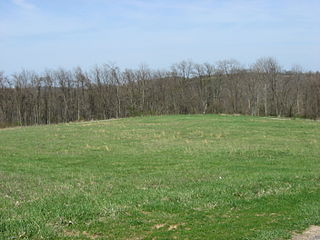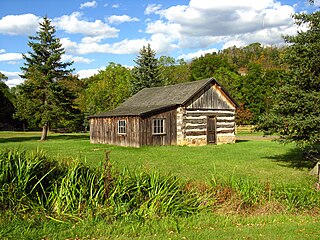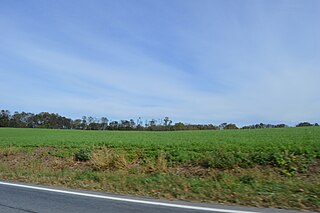
The Turpin site (33Ha28) is an archaeological site in the southwestern portion of the U.S. state of Ohio. Located near Newtown in Hamilton County, the site includes the remains of a village of the Fort Ancient culture and of multiple burial mounds. Numerous bodies have been found in and around the mounds as a result of thorough site investigations. The archaeological value of the site has resulted in its use in the study of similar locations and in its designation as a historic site.

Minisink Archeological Site, also known as Minisink Historic District, is an archeological site of 1320 acres located in both Sussex County, New Jersey and Pike County, Pennsylvania. It was part of a region occupied by Munsee-speaking Lenape that extended from southern New York across northern New Jersey to northeastern Pennsylvania. The Munsee were speakers of one of the three major language dialects of the Lenape Native American tribe. This interstate territory became the most important Munsee community for the majority of the 17th and 18th centuries.
This is a list of the National Register of Historic Places listings in Williamson County, Tennessee.

The Canfield Island Site, also known as Archeological Site 36LY37, is an archaeological site in Lycoming County, Pennsylvania, United States. Located on Canfield Island in the West Branch Susquehanna River, the site lies east of the city of Williamsport in Loyalsock Township. It is believed to have been inhabited by prehistoric Native Americans for thousands of years, with the oldest discoveries dating back to more than one millennium before Christ.

The Richard T. Foley Site is an archaeological site in Jackson Township, Greene County, Pennsylvania, United States, in the southwestern corner of the state. Located along Job Creek, the site was known since the late 1960s to local artifact collectors as a valuable collection location. Significant artifacts were discovered by landowner Richard T. Foley in 1971, when he began to plow part of the site to expand his garden. Having found bits of flint, bone, and pottery, Foley contacted local archaeologists, who soon began a three-year excavation of the property. A larger investigation was carried out by archaeologists from the Carnegie Museum of Natural History in 1982; they discovered that the area previously excavated was only the periphery of a larger campsite. Later in 1982, work led by James T. Herbstritt discovered a village site elsewhere on the property.

The Household No. 1 Site is an archaeological site in Westmoreland County, Pennsylvania, United States. Located off Timms Lane in Rostraver Township, the site lies on a bluff above the Youghiogheny River.

The Deffenbaugh Site is an archaeological site in southwestern Fayette County, Pennsylvania, United States. Located in Nicholson Township west of the borough of Smithfield, it was once occupied by a village of the Monongahela people.

The Fisher site is an archaeological site in northwestern Greene County, Pennsylvania, United States. Located along a tributary of Wheeling Creek in northern Richhill Township, it was once occupied by a Monongahela village. It has been ranked as one of southwestern Pennsylvania's most important locations for prehistoric preservation.

The Bedford Village Archeological Site (36BD90) is an archaeological site in central Bedford County, Pennsylvania, United States. Located in Bedford Township north of the borough of Bedford, it was once occupied by a Monongahela culture village. Today, the site is the location of Old Bedford Village, an open-air museum, containing a variety of historic structures transported to the site from the surrounding towns of Bedford, Everett, and Rainsburg.

The Sommerheim Park Archaeological District includes a group of six archaeological sites west of Erie, Pennsylvania in the United States. The sites are in Sommerheim Park, one of the few undeveloped areas of the Lake Erie shoreline, in Millcreek Township. This district has been listed on the National Register of Historic Places. This is one of the leading archaeological sites in the Erie area and along the southern shoreline of Lake Erie, due to the amount of artifacts and the lack of disturbance on the site.

The Book site is an archaeological site in Juniata County, Pennsylvania, United States. Consisting of the remnants of a burial mound and a prehistoric village, the site lies on both sides of Camp Resort Road in Beale Township, near the community of Beale.

The Fisher Farm site is an archaeological site in Centre County, Pennsylvania, United States. Located in fields on the outskirts of Unionville, it is one of central Pennsylvania's leading archaeological sites.

The Houserville Site is an archaeological site located near State College in Centre County, Pennsylvania, United States. Used as a stone workshop by prehistoric Native Americans ten thousand years ago, it has been recognized as a prime candidate for prehistoric preservation.

The Tudek Site is an archaeological site located near State College in Centre County, Pennsylvania, United States. Used as a stone quarry by prehistoric Native Americans ten thousand years ago, it has been recognized as a prime candidate for prehistoric preservation.

The Francis Farm Petroglyphs are a group of petroglyphs in the southwestern part of the U.S. state of Pennsylvania. Located on a boulder in Jefferson Township in the northwestern portion of Fayette County, it has been known to archaeologists since at least the middle of the nineteenth century. Despite damage in the 1930s, it remains an important archaeological site, and accordingly, it has been designated a historic site.

The Byrd Leibhart Site, designated 36 YO 170 is a historic archaeological site located in Native Lands County Park at Lower Windsor Township, York County, Pennsylvania. It was the site of a late 17th-century fortified settlement. Artifacts were first discovered in 1929, and an excavation undertaken by the Pennsylvania Historical and Museum Commission took place in July–August 1970. The excavation identified three cemeteries, a village component, stockade, and a longhouse. The excavations uncovered a range of native and European trade goods dating to the late 17th century.
The Oscar Leibhart Site, designated (36YO9) is a historic archaeological site located at Lower Windsor Township, York County, Pennsylvania. It was the site of a prehistoric and protohistoric village. The site was first discovered by 1910, with more extensive digging between 1925 and 1936. In 1956, the Pennsylvania State Museum undertook an excavation of a longhouse and grave sites. Another excavation took place in August 1975. Artifacts uncovered from the site date to the Early Woodland Period and late-17th century.
Shenks Ferry Site (36LA2) is a historic archaeological site located above Grubb Creek at Martic Township in Lancaster County, Pennsylvania. It underwent excavation in 1930-1931 and in 1973 by the Pennsylvania Historic and Museum Commission. The excavations identified the presence of a village and seasonal campsites dated to the Late Woodland period.

The Shultz-Funk Site is a prehistoric archaeological site located at Manor Township, Lancaster County, Pennsylvania. It consists of two components; the Shultz component and the Funk component. The Shultz component was first excavated in 1931, by the Pennsylvania Museum Commission. The Shultz component was the site of a large, stockaded Susquehannock period Native American village. An extensive excavation of the Funk component in 1971, revealed three distinct Shenks Ferry villages on that site. The Shultz component is dated to 1550–1600, and the Funk component to 1500–1550.



















